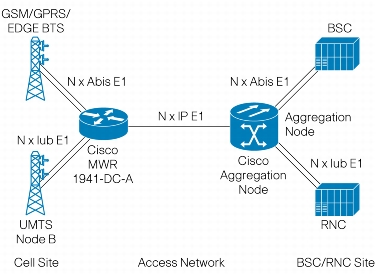The Cisco RAN Optimization Solution requires the Cisco T1/E1 RAN VWIC for terminating T1/E1s to cell-site GSM and UMTS equipment as well as for T1/E1 leased lines for backhaul. The solution enables vendor-independent, bit-transparent IP transport over 2G/3G cellular radio access networks (RANs). Optimization is done on the T1/E1 links by suppressing repeating bit patterns and not transmitting them across the backhaul network. This allows 50 percent or greater bandwidth savings on 2G networks and 15-20 percent savings on 3G networks. The Cisco T1/E1 RAN VWIC also supports standards-based Pseudowire Emulation Edge to Edge (PWE3), which allows mobile operators to offload mobile voice and data to an alternative Multiprotocol Label Switching (MPLS) network using Circuit Emulation over Packet (CEoP) technology. In addition, the Cisco T1/E1 RAN VWIC provides the ability to propagate networking clocking from end to end, which is essential for proper synchronization of voice and data on cellular networks. The Cisco T1/E1 RAN VWIC provides solid-state relays for redundancy (N+1) configurations.
For PWE3, the Cisco T1/E1 RAN VWIC supports:
• IETF draft-ietf-pwe3-cesopsn-xx.txt, Circuit Emulation Services over Packet Switched Network (CESoPSN)
• IETF RFC 4553, Structure-Agnostic Transport over Packet (SAToP)
• IETF RFC 4717, Encapsulation Methods for Transport of ATM over MPLS Networks
• IETF RFC 4454, ATM over Layer 2 Tunneling Protocol Version 3 (L2TPv3)
For Cisco OPW, IP and UDP are used as transport protocols. OPW is a pre-standard pseudowire technology with Cisco RAN Optimization function integrated in it. The protocols are very similar to the standards-based PWE3. Only its encapsulation is slightly different and has proprietary format. Users can select the pseudowire type, PWE3 or OPW, when configuring the Cisco T1/E1 RAN VWIC.
• GSM-Abis interface optimization
• UMTS-Iub interface optimization
• T1/E1 connectivity with other devices (IP backhaul)
Figure 1 provides an example of a typical application of the Cisco T1/E1 RAN VWIC.
Figure 1. Cisco T1/E1 RAN VWIC Deployment

• Ericsson
• Siemens
• Nokia
• Nortel
• Motorola
• Lucent
• Huawei
For CESoPSN or SAToP PWE3, interoperability testing has been done with the Cisco 7600 Series IPSec/VPN Shared Port Adapter (SPA). Cisco plans to make the T1/E1 RAN VWIC compatible with third-party equipment that complies with IETF standards relating to CEoP.